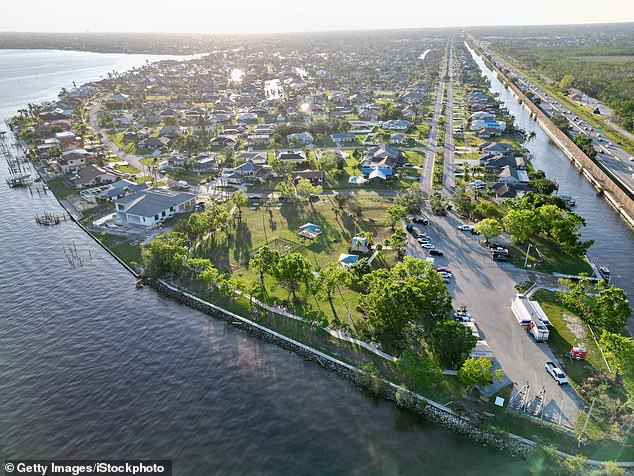Housing markets in this area are cooling the fastest in the US as pandemic boom fades
Housing markets on Florida’s west coast are cooling faster than anywhere else in the U.S., new data shows.
New construction is soaring – bringing the number of homes to pre-pandemic levels – meaning there is less competition for every home.
In addition, rising insurance costs and a sharp increase in the number of natural disasters discourage people from settling in the area.
A cooling housing market usually occurs when there are more sellers than buyers. Prices are falling and homes are being sold slowly – and below asking price – while inventory levels are rising.
The opposite happened in Florida during the pandemic, when it became one of America’s hottest markets – but there now appears to be a reversal. It gives hope to those looking to buy, but is a huge blow to those who have bought in recent years.
The housing market in North Port is cooling the fastest, followed by Tampa and Cape Coral, according to the verse analysis from Redfin.
Tampa is one of the cooling housing markets on the west coast of Florida
The cooling of these formerly red-hot markets shows that Florida’s pandemic-era home buying boom is further fading in the rearview mirror, according to Redfin.
There are also three other Florida metros on the list of the 10 markets that cooled the fastest between April 2023 and April 2024, Redfin found. These are Orlando, Jacksonville and Lakeland.
Redfin measures year-over-year changes in home prices, price declines, inventory, sales-to-list price ratio and the share of homes sold within two weeks.
In North Port, located in Sarasota County between Tampa and Fort Myers, the supply of homes for sale increased 68 percent year over year – the second-largest increase among metros analyzed by the real estate firm.
The average price per square meter has fallen by 1.2 percent and 42.6 percent of sellers in the city are lowering their asking price.
A few years ago, the Sunshine State’s housing market was considered one of the most competitive in the US. It was seen as affordable for remote workers, leading to a shortage of homes for sale.
In Tampa, which also saw a surge in home buyers during the pandemic, 43.1 percent of sellers are now lowering their asking prices, and home supply is up 62.9 percent from last April.
Meanwhile, in Cape Coral, inventory is up 64 percent, the average price per square foot is down 2.9 percent and 37.5 percent of sellers have lowered their prices – down from 32.9 percent a year earlier.
Florida is building more new homes than any other state — aside from Texas, which is also home to two of the fastest-cooling housing markets in the country.
This construction boom comes at a time when high prices and mortgage rates are dampening buyer demand.

In Cape Coral, inventory increased by 64 percent and the average price per square meter increased by 2.9 percent

Increasing natural disasters are keeping people from buying in Florida (Photo: Damage from Hurricane Ian in 2022)

Despite the softening of prices, buyers still face challenges in the area, said Isabel Arias-Squires, a Redfin agent in Cape Coral.
An increasing intensity of natural disasters – and higher insurance premiums as a result – is also deterring buyers, according to Redfin.
In the Cape Coral metro alone, Hurricane Ian destroyed 5,000 homes and damaged nearly 30,000 more in 2022.
Florida homeowners are already paying the highest premiums for coverage in the U.S., averaging $10,996 per year by 2023, according to separate data from Insurify.
According to the company’s projections, that will rise another 7 percent this year, pushing the typical premium in the state to a whopping $11,759.
“Despite the softening of prices and the influx of deals, today’s local buyers face challenges with higher mortgage rates, special assessments and the complexity of obtaining affordable flood insurance,” said Isabel Arias-Squires, a Redfin Premier agent in the Cape Coral area.
“Inventories have returned to pre-pandemic levels along Florida’s west coast as natural disasters continue to impact the region’s housing market by leading to more supply and less demand,” said Redfin Senior Economist Elijah de la Campa.
“Construction is booming due to recent climate disasters, and there is less demand for new homes as the region prepares for another intense hurricane season.”
Following Cape Coral on the list of metros with the fastest cooling housing markets are Orlando, Florida, Denver, Colorado, Houston, Texas, Minneapolis, Minnesota, Jacksonville, Florida, Lakeland, Florida and Dallas, Texas.
On the other hand, housing markets in Western New York and the Midwest are holding up best.
Rochester, New York, is the U.S. market that is heating up the most, according to Redfin, followed by Lake County, Illinois, and Buffalo, New York.
